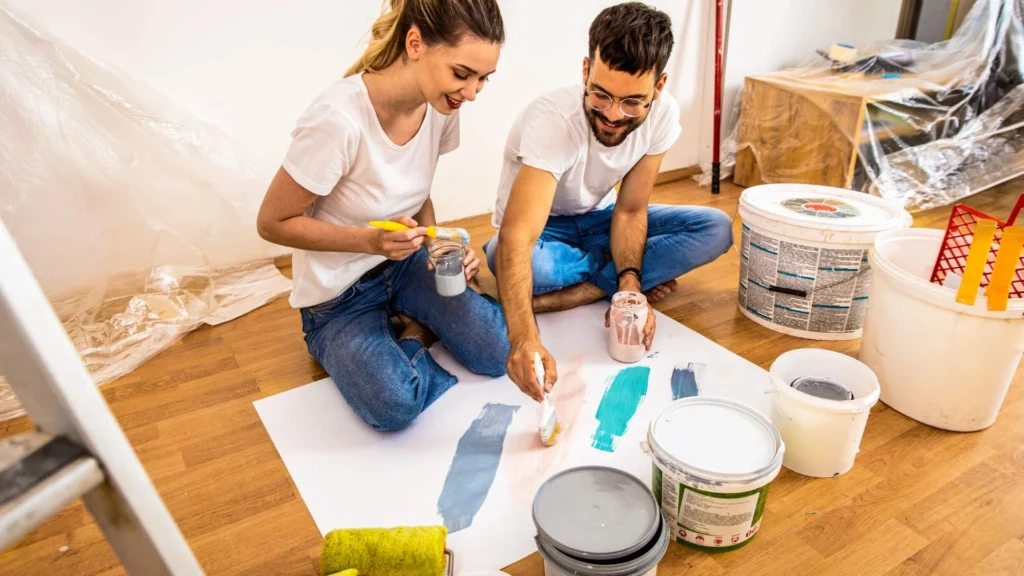Table of Contents
You don’t need a huge renovation budget to make your home more functional, comfortable, and valuable. Small, targeted upgrades, such as those that reduce friction, enhance curb appeal, or lower costs, often deliver the best return on investment in terms of both time and money. This guide walks you through 15 budget-friendly home improvement ideas that are realistic for both renters and owners, including what to expect, how to do them, rough cost and time estimates, and smart tips to help you avoid wasting effort or money.
Read this like a menu: pick three projects that solve your biggest daily pain points, finish them, then pick the next three. Small wins compound fast.
Why small home improvements matter (more than looks)
Minor upgrades make life easier every day: less stress in the morning, fewer maintenance headaches, lower utility bills, and spaces that feel fresher. They also preserve, and sometimes increase, home value without the expense and disruption of a major remodel. Best of all, many can be DIYed on weekends with minimal tools.
1. Refresh paint: walls, trim, and doors
Why it works
A fresh coat of paint instantly modernizes rooms and hides wear without breaking the bank. Color choices can also improve perceived space and light.
How to do it
Focus on high-impact spots: entryway, living room accent wall, kitchen cabinets, or interior doors. Use primer for stained areas and finish with washable paint in kitchens and kids’ rooms.
Cost & time estimate
$30–$200 per room (paint + materials); 1–2 weekend days.
Pro tips
Test paint samples on the wall and view them at different times of day. For cabinets, use semi-gloss for easier cleaning. Read about Zero Interest Home Improvement Loans
2. Replace hardware: knobs, handles, and faucets
Why it works
Swapping dated knobs, pulls, and faucets gives a designer update with tiny effort. It’s especially effective in kitchens and bathrooms.
How to do it
Measure current screw spacing before buying. For faucets, shut off the water and have a towel ready for drips.
Cost & time estimate
$5–$80 per knob/pull; $25–$200 for faucets; 1–3 hours per installation.
Pro tips
Choose matching metals across a room (brushed nickel, matte black) for cohesive style.
3. Improve lighting: bulbs, fixtures, and layered light
Why it works
Better lighting makes rooms feel larger, cleaner, and safer, and LEDs lower energy bills. Proper task and ambient light transform daily routines.
How to do it
Replace incandescent bulbs with LEDs, add under-cabinet lighting, and consider a statement pendant in the dining area. Use dimmers to control mood and energy.
Cost & time estimate
$5–$50 per bulb/fixture; small installs take 30 min–2 hours.
Pro tips
Match color temperature (2700–3000K for warm living spaces; 3500–4000K for task areas). Read about How to Save on Your Energy Bill in Winter
4. Add weatherstripping and door sweeps
Why it works
Sealing drafts improves comfort and cuts heating/cooling costs. It’s one of the fastest paybacks per dollar you’ll find.
How to do it
Install adhesive weatherstripping around windows and doors; fit door sweeps under exterior doors. Inspect annually.
Cost & time estimate
$10–$50; 30–90 minutes.
Pro tips
Check for drafts with a candle or incense on a windy day — the smoke shows leaks.
5. Upgrade kitchen backsplash or paint cabinet fronts
Why it works
A new backsplash or painted cabinet fronts modernize a kitchen without redoing counters or appliances. Tile peel-and-stick options are budget-friendly.
How to do it
Use vinyl or removable tiles for rental kitchens; for owners, grout and tile give longer life. Paint cabinets after thorough cleaning and sanding.
Cost & time estimate
$50–$400 (materials); weekend project.
Pro tips
Choose a neutral backsplash that complements both current and future appliances.
6. Install floating shelves and smart storage solutions
Why it works
Clutter makes even nice homes feel chaotic. Open shelves and add-on storage reclaim space and organize essentials within reach.
How to do it
Measure wall studs for heavier loads; use anchors for drywall. Group items by function and keep styling minimal for tidiness.
Cost & time estimate
$15–$150 per shelf; 1–2 hours.
Pro tips
Use shelves to showcase functional items (cookbooks near the stove). It looks intentional and saves steps.
7. Replace or refinish flooring accents (runners, pads, peel-and-stick tile)
Why it works
Changing a worn rug or adding peel-and-stick tile in a small section (entry, laundry) updates look cheap. It also protects subfloors.
How to do it
Use quality rug pads to protect wood floors. Peel-and-stick tiles need a clean, level surface for best adhesion.
Cost & time estimate
$20–$500 depending on size; 1 day.
Pro tips
Opt for neutral patterns that hide dirt in high-traffic zones.
Read: Home Renovation Money Plan: Budget Phases and Cost Contingencies
8. Give cabinets and drawers better organization (pull-outs, lazy susans)
Why it works
You’ll use your kitchen more efficiently when everything has a place; less waste, fewer duplicate buys. Organizational upgrades increase perceived kitchen functionality.
How to do it
Install pull-out shelves in lower cabinets, add dividers, and use clear bins for pantry items.
Cost & time estimate
$20–$200 per cabinet; 1–3 hours.
Pro tips
Measure interior cabinet depth carefully before buying pull-outs.
9. Refresh grout and caulk in wet areas
Why it works
Clean grout and fresh caulk stop water damage, mildew, and make bathrooms look cleaner instantly. They’re preventative, too.
How to do it
Scrape old caulk, clean surfaces, use mildew-resistant caulk, and tool the bead for a clean finish. Use grout pens for a quick color refresh.
Cost & time estimate
$10–$30; 1–3 hours.
Pro tips
Work in small sections and use painter’s tape for razor-straight caulk lines.
10. Add a fresh coat of exterior paint to the front door and tidy the entry
Why it works
Curb appeal matters. A bold or fresh door color and tidy entry (planter, doormat) create an immediate upgrade.
How to do it
Sand and prime the door if needed; choose a weather-resistant paint for exterior doors. Add new house numbers if old ones are dated.
Cost & time estimate
$20–$150; 1–3 hours.
Pro tips
High-contrast doors (deep blue, red) show well against neutral exteriors and photograph nicely if you plan to sell.
11. Upgrade bathroom fixtures and accessories (showerhead, towel bars, mirror)
Why it works
Small swaps modernize bathrooms with minimal mess. New showerheads can also save water and improve comfort.
How to do it
Replace showerheads, swap outdated mirrors for framed options, and install a new towel bar at a comfortable height.
Cost & time estimate
$20–$200; 1–2 hours.
Pro tips
Choose finishes that match other hardware for consistent styling.
12. Improve landscaping with mulch, native plants, and solar path lights
Why it works
Low-cost landscaping boosts curb appeal and reduces maintenance. Native plants need less water and care. Solar lights add ambiance without wiring.
How to do it
Add a layer of mulch, plant drought-tolerant perennials, and install solar path lights along walkways. Group plants with similar water needs.
Cost & time estimate
$50–$400; 1 weekend.
Pro tips
Buy small plants and let them grow. It’s cheaper than large specimen plants and creates natural variation.

13. Install a programmable thermostat and focus on HVAC tune-ups
Why it works
Heating and cooling are the biggest household expenses; controlling them smarter saves big. A tune-up improves system life and prevents expensive breakdowns.
How to do it
Install a programmable or smart thermostat; schedule annual HVAC maintenance and replace filters regularly. Consider sealing ducts if your system is older.
Cost & time estimate
Thermostat $60–$250; tune-up $75–$200.
Pro tips
Many utilities offer smart thermostat rebates. Check before you buy.
14. Create a feature wall with peel-and-stick wallpaper or wood planks
Why it works
A feature wall adds depth and design punch without the cost and time of full room treatment. Peel-and-stick options are renter-friendly.
How to do it
Choose one focal wall and align patterns carefully. For planks, stagger seams and use adhesive designed for your wall surface.
Cost & time estimate
$30–$300; 1 day.
Pro tips
Keep the rest of the room simple to let the feature wall be the star.
15. Install motion sensor or smart lighting for high-use areas (hallways, closets)
Why it works
Smart or motion-activated lights reduce wasted electricity and add convenience. No fumbling for switches during bedtime or late arrivals.
How to do it
Use battery-powered motion lights for closets; swap in smart bulbs or smart switches for main circuits.
Cost & time estimate
$10–$60 per sensor/bulb; quick installs (10–60 minutes).
Pro tips
Test sensor placement before final mounting. Avoid false triggers from curtains or pet traffic.
Plan projects by priority: safety, comfort, then style
Start with fixes that affect safety and costs (smoke detectors, HVAC tune, draft sealing), then tackle comfort (lighting, storae), and finally aesthetic upgrades (paint, hardware, feature wall). This order keeps your home livable and your budget manageable.
DIY vs. hire a pro: When to call in help
- DIY: Painting, painting cabinets, swapping knobs, installing shelves, patching grout, weatherstripping, and landscaping.
- Hire a pro: Electrical rewiring, major plumbing, structural changes, roofing, or if local codes require a licensed contractor. If in doubt, get a written estimate. Small mistakes on electrical or structural work become expensive fast.
How to source materials and save money (smart shopping hacks)
- Shop end-of-season sales for paint and tools.
- Use reclaimed materials marketplaces and Facebook Marketplace for discounted hardware and lighting.
- Price compare online + local stores; factor shipping and returns.
- Buy quality where it matters (faucets, locks); save on cosmetics (trim paint, hardware).
- Reuse and upcycle: a little sanding and a fresh finish can transform old furniture.
Financing small projects. Make it affordable and safe
If a project requires cash you don’t have now, consider these low-cost options: save in a targeted pot, use a 0% interest credit offer only if you can pay on time, or use a short, transparent advance like Beem’s Everdraft™ when a small emergency or timing mismatch happens. Everdraft™ provides access to $10–$1,000 instantly, with no interest and no credit checks, which can bridge tight moments without predatory fees. Always pair borrowings with a repayment plan so the project remains an investment, not a burden.
Maintenance checklist so improvements last
- Repaint touchups annually where wear shows.
- Clean and reseal grout/calk in bathrooms yearly.
- Exercise cabinet hinges and oil hardware.
- Rake mulch and check plant watering zones seasonally.
- Test and replace batteries in smoke/CO detectors every 6–12 months.
Small, regular maintenance prevents big, expensive repairs later.
How to measure success: simple ROI and comfort metrics
- Cost vs. value: Track what you spent and how it affected daily life (time saved, fewer repairs).
- Utility impact: Note any energy-saving upgrades and compare bills before/after.
- Happiness score: Did the household mood or ease of use improve? Ask family members.
- Resale value: For owners, track comparable listings in your area after curb-appeal or kitchen tweaks.
Value isn’t purely dollars. Comfort and reduced stress matter a lot.
Quick 30-/60-/90 day makeover plan
- 30 days: Paint one room or the door, swap hardware, seal drafts, replace high-use bulbs.
- 60 days: Add shelves and pantry organization, refinish grout, update lighting fixtures.
- 90 days: Landscape entry, install programmable thermostat, finish a feature wall.
Pace yourself. Small staged wins keep momentum and cash flow steady.
Common mistakes to avoid (so your budget stretches further)
- Overbuying materials you won’t use.
- Starting multiple projects at once and never finishing them.
- Choosing trend over timeless when selling is likely.
- Ignoring local permits or building codes for anything structural.
- Skimping on safety (electrical, gas). Never DIY what’s dangerous.
Small investments, big daily returns
Affordable home improvements aren’t about imitation magazines; they’re about solving everyday frictions cheaply and stylishly. Pick projects that matter to how you live like better lighting where you read, a tidier kitchen for faster dinners, a sealed door for lower bills. Plan, prioritize, and use smart financing when necessary. Over time, these small upgrades add comfort, save money, and make your home feel intentionally cared for. Download the Beem app here.
FAQs on Budget-Friendly Home Improvement Ideas
What are the top three projects that deliver the biggest impact for the least money?
Paint refresh (walls/doors), swapping hardware (knobs/fixtures), and sealing drafts (weatherstripping/door sweeps). These three dramatically improve aesthetics, function, and energy costs at low price.
How can renters improve a space without losing their deposit?
Use removable options: peel-and-stick tile or wallpaper, temporary hooks and shelves, removable cabinet hardware (screw holes can be filled), and renter-friendly light swaps like plug-in lamps. Always document and restore before moving out if required.
When should I hire a pro instead of DIY?
Hire pros for anything involving electricity, major plumbing, structural work, roofing, or when local code requires permits. If the job risks safety or major damage, a licensed contractor typically saves money and stress in the long run.















































